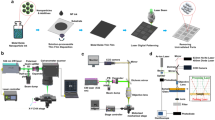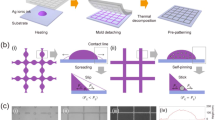Abstract.
There has been increase in interest in flexible electronics for roles in applications such as wearable electronics, and solar technology. Current technologies for fabricating flexible electronics tend to rely on costly nanomaterials as raw materials. This paper presents an alternative processing method that circumvents the need for pre-fabricated nanomaterials, while still achieving comparable electrical properties. Direct Laser Writing (DLW) is a new manufacturing technique where an aqueous copper ion film is applied to a flexible substrate and then selectively irradiated with focused laser energy to produce a resulting structure of interconnected copper nanoparticles in a single step. During DLW laser energy simultaneously reduces the copper ions present in the solution to form nanoparticles, and subsequently sinters the nanoparticles into a continuous structure. In addition to being low cost DLW also benefits from being suitable at room temperature and not requiring or producing any environmentally harmful materials. Through controlling laser parameters the chemical composition of the copper can be controlled, resulting in a high degree of control over the electrical properties of the resulting patterns. We demonstrate in this paper the ability to achieve flexible patterns with conductive and semi-conductive electrical properties. Finally, we intend to demonstrate the unique capabilities of DLW by showcasing some of the flexible electronic devices we have been able to fabricate using DLW. Namely a memresistive Copper / Copper Oxide junction.
Access provided by Autonomous University of Puebla. Download conference paper PDF
Similar content being viewed by others
Keywords:
- Flexible electronics
- Direct laser writing
- Copper nanomaterials
- Laser reduction
- Nanofabrication
- Resistive switching
- Memristor
1 Introduction
There has been a growing interest in flexible electronics over the past several years [1]. The industries of medicine and healthcare [2], consumer electronics [3], and smart textiles [4] are among the key industries leading the push for next-generation flexible electronic devices. Currently, most of the fabrication processes capable of producing high-quality flexible electronic components rely on costly raw materials such as precious metals or nanoparticles [5]. As well, most of the fabrication methods utilize complex multi-step procedures that offer low throughput [6]. These two factors of prohibitive cost and low production rate are currently two of the largest hurdles preventing the advancement of flexible electronics. As such, there is a desire for a fabrication method that can produce high-quality components with inexpensive raw materials and high production capabilities.
Direct Laser Writing (DLW) is a novel fabrication technique wherein a flexible substrate is coated in a thin metal ion film and irradiated with focused laser energy. The laser energy reduces the metal ions into metal nanoparticles, and then instantaneously interconnects those particles to form continuous flexible conductive patterns. To date, DLW has been demonstrated to be capable of fabricating high-quality flexible electronic components such as flexible electrodes [5] and sensors [7]. In this work, we will be presenting a DLW procedure capable of rapidly producing flexible copper patterns. Furthermore, we will demonstrate the ability to precisely control the electrical properties of the deposited copper patterns through controlling key laser parameters, of laser speed, power, and defocus. The potential of DLW as a method of producing flexible electronic components suitable for next-generation applications is then demonstrated through the production of a novel flexible memristive interdigital electrode component.
2 Experimental
A copper ion solution comprised of copper nitrate (Cu(NO3)2), polyethylene glycol (PEG), polyvinyl pyrrolidone (PVP), and deionized water was drop casted onto a flexible polycarbonate sheet and dried to remove excess moisture. The copper ion solution was then irradiated with focused laser energy to deposit copper patterns onto the PC substrate. The untreated regions of the copper ion film were then rinsed using deionized water to leave only the copper patterns on the substrate. The conductivity of the printed patterns was measured in order to investigate the effects of changing laser parameters on electrical properties. The chemistry and microstructure of the deposited patterns were also investigated in order to better relate the electrical properties of the patterns to key chemical and microstructural changes.
3 Results and Discussion
Patterns at varying laser speeds and powers were deposited, and the resistivity of the patterns was measured. Immediately it is clear that the chemical composition of the deposited patterns varies with increasing laser power density, as shown in Fig. 1a. At low laser power, the patterns exhibit a dark grey color and at increasing laser powers, the patterns shift to a red-brown color. The red-brown is associated with metallic copper and the grey color is indicative of copper oxide. The change in chemical composition of the pattern with increasing laser power is a result of the reduction mechanism that enables the reduction of the copper ion film to metallic copper, through the photodegradation of PVP [5]. During laser irradiation, the lactam side ring group of PVP molecule is degraded through the assistance of the hydroxyl group contributed by the end groups of the PEG molecules. The lactam ring degrades into methylamine, amorphous carbon, methylene, and formic acid. The formic acid is then able to react with the copper ions in solution and reduce them from the +2 state to the +1 state, and then subsequently to the metallic state [7]. Figure 1b shows the reduction of copper ions through the formation of formic acid from PVP. At high laser power treatment parameters, there is enough photodegradation of the PVP molecules to generate an abundance of formic acid. As a result, the majority of the copper ions are fully reduced from the 2+ state, to the metallic state. At decreasing laser energies, there is less degradation of the PVP, which results in less formic acid. Subsequently, there is not enough formic acid present to fully reduce most of the copper ions, as such many copper ions are only partially reduced to the 1+ state, and form Copper(I)Oxide. This trend of increasing Copper(I)Oxide at decreasing laser energies is reflected in the conductivity of the patterns deposited at lower laser energies. Figure 1c shows the resistivity of patterns printed with varying laser power densities. Since metallic copper is a much better electrical conductor than Copper(I)Oxide, increasing amounts of Copper(I)Oxide result in dramatic reductions in the conductivity of the deposited patterns. XRD analysis of the deposited patterns revealed that at a laser energy of 1 watt roughly half of the copper in the pattern was deposited as Copper(I)Oxide, at 1.5 watts Copper(I)Oxide content decreased to about 15% and above 2 watts the Copper(I)Oxide content is below 10%.
The need for highly conductive flexible patterns for flexible electronics is self-evident [1]. However, there is also growing interest into utilizing the properties of copper oxides. Copper oxides have been shown to have outstanding catalytic properties [6], which have made them ideal choices for use in sensing applications. As well, there is growing interest in using copper oxide as a semiconductor. Copper(I)Oxide is a natural p-type semiconductor, wherein oxygen vacancies act as electron receptors [8]. Copper(I)Oxide has demonstrated resistive switching effect where it can be set to either a high or low resistivity state through the application of a voltage bias. The resistive switching observed in Copper(I)Oxide is a result of the reversible formation of a conductive filament through the migration of oxygen vacancies [9]. The resistive switching capabilities of Copper(I)Oxide are the basis of a novel new electrical component known as a memristor. Memristors show promise in many roles in advanced electronics such as memory units and logic gates [10]. The ability for DLW to deposit both copper and Copper(I)Oxide patterns makes it an ideal process for the fabrication of memristive components.
A novel memristive interdigital electrode component has been fabricated in a single step using DLW, shown in Fig. 2a. By tuning laser energy parameters throughout the laser writing procedure, different regions of the pattern exhibit different properties. Copper-rich electrodes were printed with a laser setting of 4 W at 10 mm/s and copper(I)oxide-rich interdigital regions were printed with a laser setting of 1.55 W at 5 mm/s. A voltage bias was applied from 0 - +1 V, +1 V - −1 V, −1 V – 0. The current flowing through the component was measured. Figure 2c shows the current–voltage plot of the fabricated component. Upon applying +1 V, the resistance of the junction dropped to a low resistance state (LRS). This indicates the formation of the conductive filament linked one copper region to another. Applying −1 V returned the junction to the high resistance state (HRS), indicating that the formation of the conductive filament has been reversed.
4 Conclusions
In summary, a new novel procedure that can produce high-quality flexible electronic components has been presented. Highly conductive patterns can be produced without the need for expensive raw materials, and in a single-step process. These aspects of DLW make it very relevant to the growing need for next-generation flexible electronics. It was shown that the reduction of copper ions through the photodegradation of PVP allows for a high degree of control over the chemical composition of the fabricated copper structures. By leveraging this control over chemical composition, a novel memristive junction was fabricated, and the current–voltage loop characteristics were presented.
References
Logothetidis S. Handbook of flexible organic electronics: materials, manufacturing and applications. Waltham: Woodhead Pub; 2014.
Someya T, Sekitani T, Iba S, Kato Y, Kawaguchi H, Sakurai T. A large-area, flexible pressure sensor matrix with organic field-effect transistors for artificial skin applications. Proc Natl Acad Sci. 2004;101(27):9966–70. https://doi.org/10.1073/pnas.0401918101.
Loher T, Seckel M, Pahl B, Bottcher L, Ostmann A, Reichl H. Highly integrated flexible electronic circuits and modules. In: 2008 3rd international microsystems, packaging, assembly circuits technology conference; 2008, Oct. p. 86–9. https://doi.org/10.1109/IMPACT.2008.4783814.
Kim J, Lee T-I, Shin J, Kim T-S, Paik K. Bending properties of anisotropic conductive films assembled chip-in-flex packages for wearable electronics applications. IEEE Trans Compon Packag Manuf Technol. 2016:208–15. https://doi.org/10.1109/TCPMT.2015.2513062.
Peng P, et al. One-step selective laser patterning of copper/graphene flexible electrodes. Nanotechnology. 2019;30(18):185301. https://doi.org/10.1088/1361-6528/aafe4c.
Zhou X, Guo W, Yao Y, Peng R, Peng P. Flexible nonenzymatic glucose sensing with one-step laser-fabricated Cu2O/Cu porous structure. Adv Eng Mater. 2021;23(6):2100192. https://doi.org/10.1002/adem.202100192.
Zhou X, Guo W, Fu J, Zhu Y, Huang Y, Peng P. Laser writing of Cu/Cu O integrated structure on flexible substrate for humidity sensing. Appl Surf Sci. 2019;494:684–90. https://doi.org/10.1016/j.apsusc.2019.07.159.
Sawa A. Resistive switching in transition metal oxides. Mater Today. 2008;11:28–36. https://doi.org/10.1016/S1369-7021(08)70119-6.
Rehman S, Hur J-H, Kim D. Resistive switching in solution-processed copper oxide (Cu x O) by stoichiometry tuning. J Phys Chem C. 2018;122(20):11076–85. https://doi.org/10.1021/acs.jpcc.8b00432.
Liu H. Laser assisted ink-printing of copper oxide nanoplates for memory device. Mater Lett. 2020;261:4.
Acknowledgments
We would like to acknowledge the support of NSERC research grants, for supporting the work.
Author information
Authors and Affiliations
Corresponding author
Editor information
Editors and Affiliations
Rights and permissions
Copyright information
© 2023 The Author(s), under exclusive license to Springer Nature Switzerland AG
About this paper
Cite this paper
Jones, J., Peng, P. (2023). Direct Laser Writing of Copper/Copper Oxide Patterns for Emerging Roles in Advanced Electronics. In: Proceedings of the 61st Conference of Metallurgists, COM 2022. COM 2022. Springer, Cham. https://doi.org/10.1007/978-3-031-17425-4_11
Download citation
DOI: https://doi.org/10.1007/978-3-031-17425-4_11
Published:
Publisher Name: Springer, Cham
Print ISBN: 978-3-031-17424-7
Online ISBN: 978-3-031-17425-4
eBook Packages: Chemistry and Materials ScienceChemistry and Material Science (R0)






